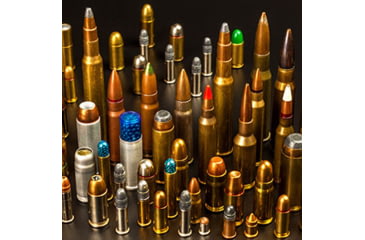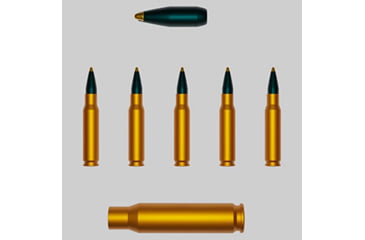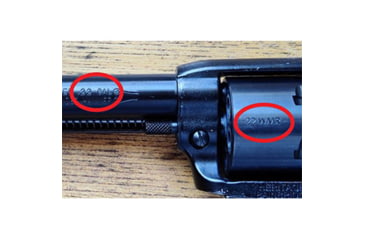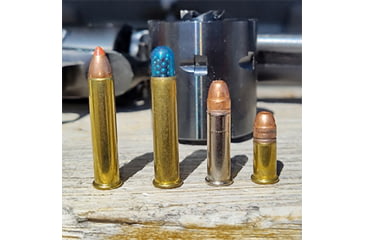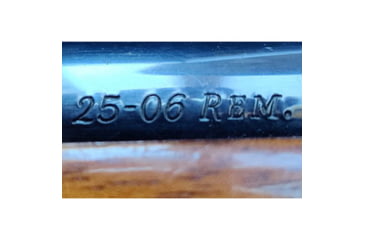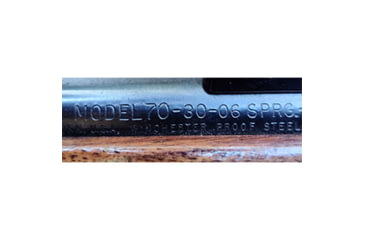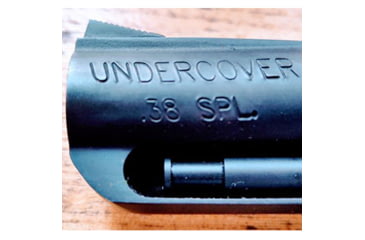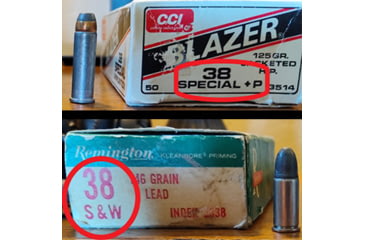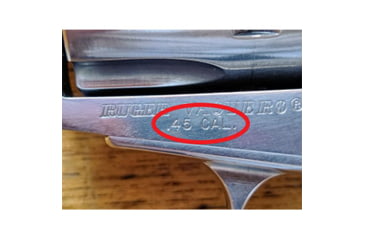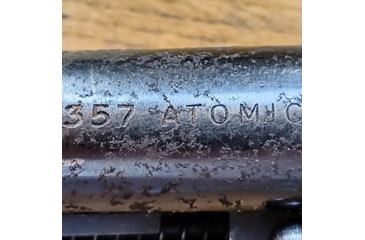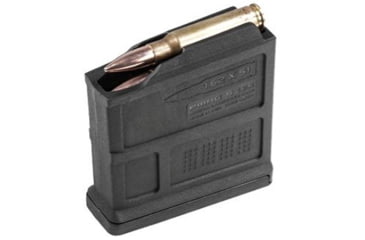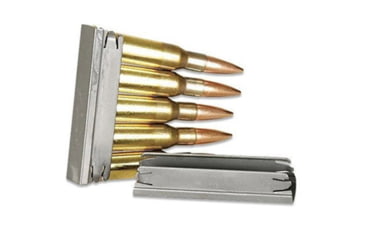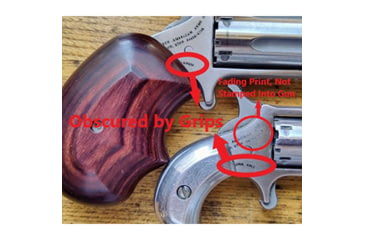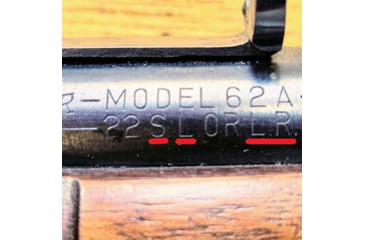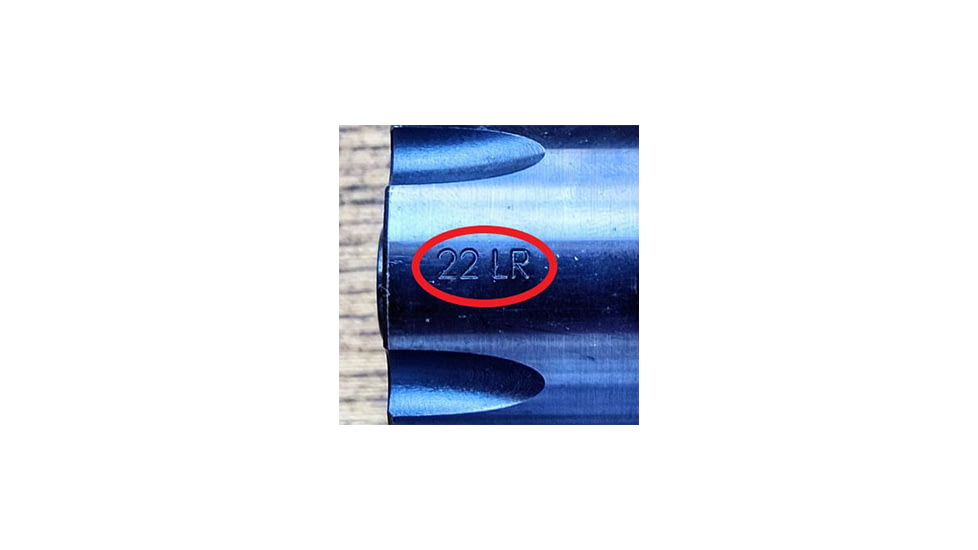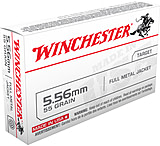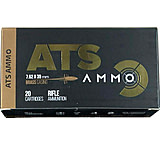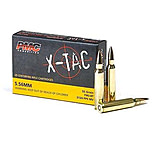Ever wondered why ammunition can have different names even when some cartridges seem to have the same bullet sizes? The bullet caliber refers to the diameter of the projectile, but it often doesn't represent the gun caliber accurately. Now you're probably asking, "Then how are rifle calibers and handgun calibers determined?" The real question is, "Why are caliber names so crazy?" Come on down the rabbit hole, this one's really Wylde*.![]()
*That's a gun joke, although .223 Wylde is a chamber, not a caliber.
Bullet Sizes | Bullet Caliber | Gun Caliber | Chamber
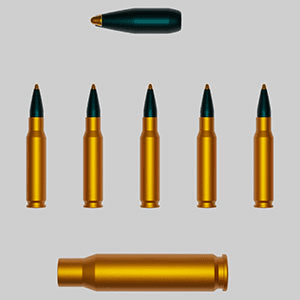 For starters, we need to clear up some commonly misused terms and some terms that are used interchangeably. Most of the time, you'll probably get away with calling ammo "bullets," but people will snicker behind your back. You will also eventually stumble across a picky pedantic pontificator who will sermonize on the semantics, so here's a primer (another gun pun):
For starters, we need to clear up some commonly misused terms and some terms that are used interchangeably. Most of the time, you'll probably get away with calling ammo "bullets," but people will snicker behind your back. You will also eventually stumble across a picky pedantic pontificator who will sermonize on the semantics, so here's a primer (another gun pun):
- Bullet: This is only the projectile that is expelled from the pointy end of a firearm. It is commonly misused because people mean to refer to cartridges. Bullet sizes simply refer to the dimensions of the projectile by diameter, length, and weight in grains. Bullets are reloading components, used by handloaders who want to make their own ammunition using specialized reloading equipment.
If you walk into a gun shop and ask for ".223 bullets," a clerk may ask if you are looking for reloading components or live ammo. This is because the employees deal with reloaders who really are just looking for the projectiles, and they deal with people who are new to firearms and are really just looking for live ammunition. - Cartridge: This is more commonly called "ammunition," "ammo," or "rounds". It's ready to load into a gun and fire. It is made up of a bullet, powder, casing (shell), and primer.
Just to make things more confusing, gun folks often use "casing" and "shell" interchangeably, and "shells" and "ammo" interchangeably, but never "casing" and "ammo". There are a lot of oddities like this in gun lingo. - Bullet Caliber: This refers to the diameter of the bullet. You can have many different firearms that use the same caliber of bullets (from Ballistics 101) but have considerably different cartridges.
For example, all of the following handgun cartridges have the same bullet caliber of 9mm, but only one of them is the 9mm we're usually referring to (9 mm Parabellum/Luger/NATO/9x19 mm). So not counting that one, there are at least 17 others:
-
- 9 mm Ultra (9 mm Police, 9x18 mm)
- 9 mm Glisenti
- 9 mm Federal (9x19 mmR)
- 9 mm Browning Long (9x20 mmSR)
- 9x21 mm (9 mm IMI)
- .356 TSW (9x21.5 mm)
- 9 mm Action Express (9 mm AE)
- .38-45 Auto (.45-38 Clerke, .45-38 Hard Head)
- 9 mm Steyr (9x23 mm Steyr)
- 9 mm Largo (9 mm Bergmann-Bayard, 9x23 mm)
- 9mm Makarov (9x19mm PM)
- 9 mm Dillon (9x25 mm Dillon)
- 9 mm Mauser (9x25 mm Mauser)
- 9 mm Winchester Magnum
- .380 ACP (9 mm Kurz, 9mm Short, 9x17 mm)
- 9x23 mm Winchester
- .38 Casull
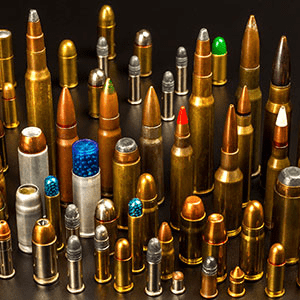 That's just one caliber of bullet and ONLY the handguns; it's not even getting into all of the rifles that use a 9 mm bullet. Although they have different cartridges and often differing grain weights, technically they're all 9mm's! So you can have the same pistol bullet sizes but entirely different pistol ammo sizes. As you can see, they also often have names that don't mention the 9-millimeter measurement at all. This is usually (but not always) due to imperial vs. metric measurements.
That's just one caliber of bullet and ONLY the handguns; it's not even getting into all of the rifles that use a 9 mm bullet. Although they have different cartridges and often differing grain weights, technically they're all 9mm's! So you can have the same pistol bullet sizes but entirely different pistol ammo sizes. As you can see, they also often have names that don't mention the 9-millimeter measurement at all. This is usually (but not always) due to imperial vs. metric measurements.
- Gun Caliber: This usually refers to the actual cartridges that the firearm uses. However, sometimes people are referring to the inner diameter of the gun's barrel. These are measured by either the grooves or the lands (ridges) in the rifling, depending on how it was initially measured when the caliber was invented. Confusing? Yeah, it's like that.
- Chamber: This is the rear portion of the gun barrel where the ammunition sits when it's ready to be fired. It's important to know that because you may hear the term "chambered in ___." Many gun models are offered in a variety of calibers, even though it's the same firearm. The chamber dictates which particular cartridge the gun uses.
I was chatting with a buddy and mentioned that I grew up hunting with a Ruger M77. He mentioned that he did, too, and asked me, "What was yours chambered in?" I told him mine was a .25-06; he told me his was a .243 Win. and I replied, "That's a good caliber for deer." These rifles are identical except for the ammo they use. It's quite a bit like shoe sizes.
Here we find another weird aspect of gun lingo. Even though technically "caliber" only refers to the diameter of the gun barrel or bullet, when gun people refer to the caliber, they almost always mean the cartridge that the gun is chambered for.
I realize that this is confusing for gun noobs, so I'll boil it down:
- Only refer to bullets when you're talking about the projectile. Otherwise, just call it "ammo," and everyone will understand that you know the difference. "Cartridges," "ammunition," and "rounds" are also acceptable. You probably want to avoid calling them "shells" to avoid a lecture until you're more comfortable, even though it's another commonly used term.
- Although "caliber" can technically mean a lot of different things, it usually means what kind of ammo your gun takes.
- A gun is "chambered in" a specific caliber which also means the specific ammunition that a firearm is designed to use.
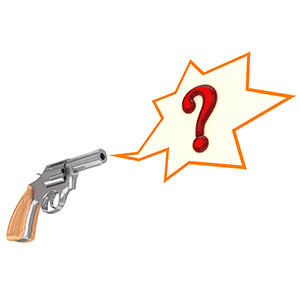 Why Is It Important To Understand These Caliber Names?
Why Is It Important To Understand These Caliber Names?
The most important reason is safety. There is no set, standardized system of naming different calibers, and it's unlikely that there ever will be. For reference, SAAMI (Sporting Arms and Ammunition Manufacturers' Institute) keeps a comprehensive and constantly updated list of all firearm calibers, mostly for safety reasons. Just because ammo fits in a gun doesn't mean it should be fired out of it, as this can damage the firearm and result in serious injury or death. Always make sure you check the markings on your firearm and understand what they mean before you fire any ammunition through it. SAAMI has a really good list of Unsafe Firearm & Ammunition Combinations, too. You may come upon internet videos featuring people deliberately firing incorrect ammunition to see what might happen. Some of these videos end in disaster, so don't try this at home.
Checking Your Markings
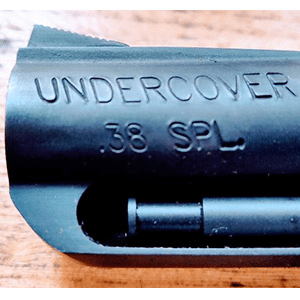 The best way to make sure you are loading the correct ammunition is to carefully check the markings on your firearm and ensure that they line up exactly with the name on the box. On modern firearms, this is usually very straightforward, as seen on this .38 Special (SPL) revolver.
The best way to make sure you are loading the correct ammunition is to carefully check the markings on your firearm and ensure that they line up exactly with the name on the box. On modern firearms, this is usually very straightforward, as seen on this .38 Special (SPL) revolver.
Multiple Calibers in One Gun
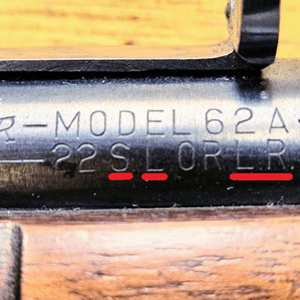 Sometimes, manufacturers will mark guns indicating that they can fire different calibers of similar ammunition, as seen on this old Winchester 62A .22 gallery gun. It's marked to indicate it can use .22 Short (S), .22 Long (L), and .22 Long Rifle (LR). This is interesting because there isn't a lot of need for this information since nearly any non-semiautomatic .22 LR can also fire .22 Longs or .22 Shorts. Anecdotal history indicates that this was because these guns were designed for shooting galleries, where it wouldn't be uncommon to have a rifle that only took .22 Shorts sitting next to one that was a .22 Long (that can also use .22 Short) and another like the one pictured. It allowed the shooting gallery attendant to identify which was which at a glance so it could quickly be reloaded, keeping those customers shooting and the money rolling in.
Sometimes, manufacturers will mark guns indicating that they can fire different calibers of similar ammunition, as seen on this old Winchester 62A .22 gallery gun. It's marked to indicate it can use .22 Short (S), .22 Long (L), and .22 Long Rifle (LR). This is interesting because there isn't a lot of need for this information since nearly any non-semiautomatic .22 LR can also fire .22 Longs or .22 Shorts. Anecdotal history indicates that this was because these guns were designed for shooting galleries, where it wouldn't be uncommon to have a rifle that only took .22 Shorts sitting next to one that was a .22 Long (that can also use .22 Short) and another like the one pictured. It allowed the shooting gallery attendant to identify which was which at a glance so it could quickly be reloaded, keeping those customers shooting and the money rolling in.
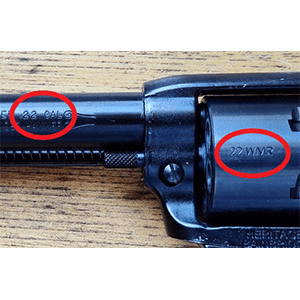

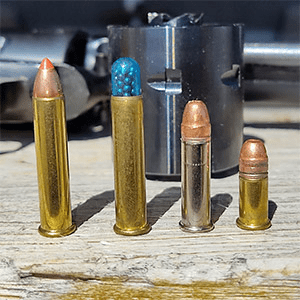 Although uncommon in most other calibers and types of firearms, there are several .22 revolvers that allow an extra interchangeable cylinder to be used that will fire .22 WMR (Winchester Magnum Rimfire). Unlike a .22LR, the .22 Mag. (WMR) can't be used to fire the smaller cartridges. In these cases, the barrel will often be stamped ".22 Cal." and the cylinder will show which one you have installed in the revolver, as seen here, along with examples of .22 WMR (two cartridges on left), .22 Long Rifle, and .22 short (far right).
Although uncommon in most other calibers and types of firearms, there are several .22 revolvers that allow an extra interchangeable cylinder to be used that will fire .22 WMR (Winchester Magnum Rimfire). Unlike a .22LR, the .22 Mag. (WMR) can't be used to fire the smaller cartridges. In these cases, the barrel will often be stamped ".22 Cal." and the cylinder will show which one you have installed in the revolver, as seen here, along with examples of .22 WMR (two cartridges on left), .22 Long Rifle, and .22 short (far right).
There are other less common devices called "moon clips" that allow various different revolvers to fire other calibers than the ones they're originally chambered for, too.
Less Straightforward Markings
There are some cases where older guns don't seem to be marked at all. Sometimes they have to be taken apart to find out since the stampings may be under different components. If you're not familiar enough, take it to a gun shop for help disassembling it to avoid damaging it or losing any parts.
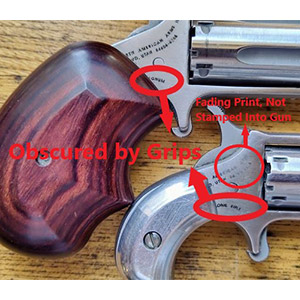
There are some situations where the gun is marked, but there are issues deciphering the markings. In this example, there are two issues: both mini-revolvers have after-market grips that obscure the full name of the calibers, and instead of being stamped into the metal, they're just printed on. The lower pistol is an example of how that can be problematic since after over 20 years of carry-wear, the print is fading away.
Old Guns and Unusual Calibers
You may inherit or even buy an old gun that is marked with something you've never even heard of. Use a lot of caution in these situations before trying it out. For one, it may not be in a safe condition, like a gun that's rusted out and pitted. Another reason is that many old cartridge-firing guns were designed for cartridges loaded with black powder, the same stuff still used for muzzleloaders today. Modern cartridges use smokeless powder, which can cause much greater pressure than old-fashioned black powder.
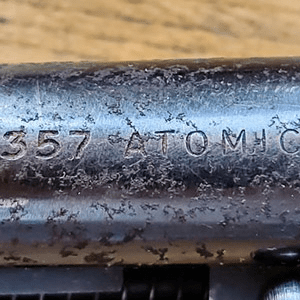 In the example here, there are several things to point out. First and foremost is that the gun's rusted, pitted, and desperately in need of a long, expensive trip to the gunsmith to be repaired and cleared by a professional for use before even considering firing it. Second, it's marked ".357 Atomic," a strange thing indeed. I took it to the most knowledgeable gun guy I know, and he'd never heard of such a thing. Some internet sleuthing turned up that it's an obscure Great Western Arms revolver designed to shoot "hot loads" in excess of the original .357 Magnum, while also being able to fire regular .357 Mag. and .38 Special. In 1954-1955 this made it the most powerful handgun in the world, but then the .44 Magnum came along, and the old Atomic faded off into the sunset.
In the example here, there are several things to point out. First and foremost is that the gun's rusted, pitted, and desperately in need of a long, expensive trip to the gunsmith to be repaired and cleared by a professional for use before even considering firing it. Second, it's marked ".357 Atomic," a strange thing indeed. I took it to the most knowledgeable gun guy I know, and he'd never heard of such a thing. Some internet sleuthing turned up that it's an obscure Great Western Arms revolver designed to shoot "hot loads" in excess of the original .357 Magnum, while also being able to fire regular .357 Mag. and .38 Special. In 1954-1955 this made it the most powerful handgun in the world, but then the .44 Magnum came along, and the old Atomic faded off into the sunset.
Where All the Crazy Names Come From
The primary reason that ammunition has so many different sorts of names is that they've been developed over hundreds of years and all over the world.
- History: Different calibers have been named in several different ways over time. Once cartridges came along, a variety of methods were devised to name them, but again there was no standardization. So the .45-70 Gov't was named for the .45 caliber bullet, the 70 grains of powder, and the adoption by the U.S. Government.
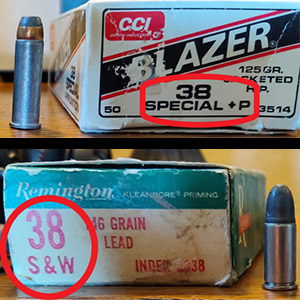 The .38 Special was named because it was a conversion from a .36 caliber cap and ball revolver to allow it to shoot cartridges instead of manually reloading each chamber with powder and bullets. This is not to be confused with the mostly obsolete and hard-to-find .38 S&W (.38 Short Colt) cartridge, a totally different critter. This picture shows how easily the boxes might be confused but how obvious the difference is.
The .38 Special was named because it was a conversion from a .36 caliber cap and ball revolver to allow it to shoot cartridges instead of manually reloading each chamber with powder and bullets. This is not to be confused with the mostly obsolete and hard-to-find .38 S&W (.38 Short Colt) cartridge, a totally different critter. This picture shows how easily the boxes might be confused but how obvious the difference is.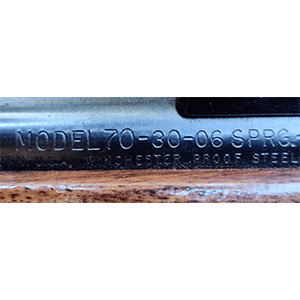 The 30-06 Springfield was conceived differently. It starts with the .30 caliber bullet, but then the "06" stands for the year it was adopted by the U.S. Army beginning in 1906, and "Springfield" from the Springfield Armory. Here we see that the model has been strung into the abbreviated name. This is not a "70-30-06," it's a Winchester Model 70 .30-06 Springfield (SPRG).
The 30-06 Springfield was conceived differently. It starts with the .30 caliber bullet, but then the "06" stands for the year it was adopted by the U.S. Army beginning in 1906, and "Springfield" from the Springfield Armory. Here we see that the model has been strung into the abbreviated name. This is not a "70-30-06," it's a Winchester Model 70 .30-06 Springfield (SPRG). 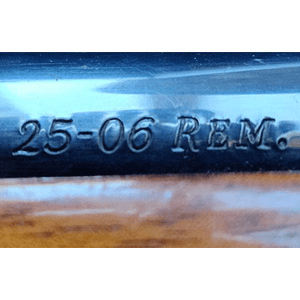 Proprietary: Often ammunition names will have a company name, inventor's name, or marketing name. For instance, the 25-06 Remington is named after the .25 caliber bullet, the parent casing of the 30-06, and the Remington company who began manufacturing it. Up until then, it was a "wildcat" cartridge. A "wildcat" is a cartridge that's tinkered with and modified by skilled amateur gunsmiths and handloaders to get a desired effect, in this case using the necked down casing of a 30-06 shell to .25 caliber to reduce bullet drop and increase accuracy.
Proprietary: Often ammunition names will have a company name, inventor's name, or marketing name. For instance, the 25-06 Remington is named after the .25 caliber bullet, the parent casing of the 30-06, and the Remington company who began manufacturing it. Up until then, it was a "wildcat" cartridge. A "wildcat" is a cartridge that's tinkered with and modified by skilled amateur gunsmiths and handloaders to get a desired effect, in this case using the necked down casing of a 30-06 shell to .25 caliber to reduce bullet drop and increase accuracy.
The 9mm Luger is the 9-millimeter diameter of the bullet followed by the name of the inventor, George Luger, when he was simultaneously inventing the venerable Luger pistol. Notice this is metric because it was invented in Europe instead of the United States, where we usually see imperial units in the naming conventions.
An example of a marketing name is the .22 Hornet. Unlike most other .22's at the time, this was a centerfire instead of a rimfire. Mostly for varmint hunting, they wanted the name to imply that the small caliber had a big sting.- Retroactive: Interestingly, a caliber's name used to change as new cartridges were introduced. This wasn't always how it was done, and we don't do it at all anymore. Still, it's an interesting bit of history that explains why you run into a few versions that seem like pretty much the same thing.
The .22 was originally a small rimfire cartridge used for target practice and pest control. There were some derringers manufactured for self-defense because of the easy concealability of a pistol in this caliber, but they were woefully ineffective. The old saying that they only kill by lead poisoning is pretty true. Later, a bigger .22 rimfire was invented, named the .22 Long. Suddenly the original .22 was now the .22 Short. Then a slightly larger cartridge was invented primarily for use in longer-barreled rifles, and that's how we came to have the most common .22 Long Rifle. More on that in the next section.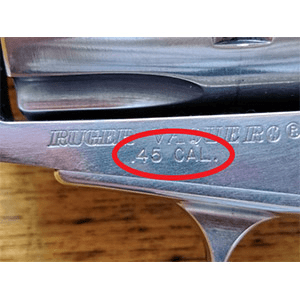 Another notable example is the .45 Colt. This is a pistol round originally made for Colt revolvers. When the .45 ACP (Automatic Colt Pistol) was invented, there was some confusion about which was which because Colt was still making and marketing guns in each different chambering. So the original cartridge was renamed the ".45 Long Colt" because the cartridge was longer than the new ACP designed for semiautomatic firearms. It's also often just called a ".45 Long," and sometimes a ".45 LC." To this day, new gun owners often don't realize there's a difference and buy the wrong box of ammo. When they get it home and try to load it, they realize it doesn't fit correctly in their firearm. Since nobody accepts returns on ammunition due to safety reasons, they're left to buy another box of the correct .45 ammo, and lesson learned. As this picture illustrates, that may take some further research because some modern production firearms are still only labeled ".45 Cal.," so you need to know what you have.
Another notable example is the .45 Colt. This is a pistol round originally made for Colt revolvers. When the .45 ACP (Automatic Colt Pistol) was invented, there was some confusion about which was which because Colt was still making and marketing guns in each different chambering. So the original cartridge was renamed the ".45 Long Colt" because the cartridge was longer than the new ACP designed for semiautomatic firearms. It's also often just called a ".45 Long," and sometimes a ".45 LC." To this day, new gun owners often don't realize there's a difference and buy the wrong box of ammo. When they get it home and try to load it, they realize it doesn't fit correctly in their firearm. Since nobody accepts returns on ammunition due to safety reasons, they're left to buy another box of the correct .45 ammo, and lesson learned. As this picture illustrates, that may take some further research because some modern production firearms are still only labeled ".45 Cal.," so you need to know what you have. - Metric: Generally speaking, this applies to calibers that were conceived in Europe. However, there are a lot of new calibers coming out in the U.S., like the 6.5 Creedmoor and the 6.5mm Grendel that have adopted metrics and are not suffering in popularity.
Another time you'll see metrics is when a caliber is adopted by militaries, particularly NATO calibers. This is why the civilian .308 Winchester is also known as 7.62x51mm NATO. There are slight variations, but they're essentially the same thing.
This is also why you might see 9mm Luger listed as 9x19 mm since that's the metric designation. These kinds of caliber names refer to the size of the bullet (9) and the length of the cartridge (19mm). It's definitely the most straightforward method of naming, but it never really took off here in the United States. - Rounding Off: There are a lot of instances where actual measurements have been rounded off, sometimes for brevity and sometimes to distinguish them from other calibers. 7mm cartridges actually use 7.21mm bullets, for instance. .22 rimfires actually use a .223 caliber bullet, the same diameter as a .223 Remington/5.56mm NATO, but using completely different types of bullets.
Understanding What You're Hearing
To top it all off, there is an inconsistent way of referring to different calibers in conversation. There's no real rhyme or reason to it, but they're ingrained so deeply that nobody would pronounce them differently. A lot of them are like nicknames, with words like "Remington" often referred to as "Rem.," or left out entirely (the .223 Remington, for instance, is almost always called a ".223"). Here are some of the most common things you'll hear and what is meant:
- Decimals: For the most part, they're silent. So a .223 is either pronounced "Two-Two Three" or "Two Twenty-three." A 5.56mm NATO is a "Five Five Six."
A .22 is pronounced "Twenty-two." This is a fun one because if you just say "Twenty-two," it's a given that you're talking about the .22 Long Rifle. If there's a word or number after it, you're talking about something else that may or may not be in the same rimfire family. Even gun people will incorrectly refer to a .22 LR as a "Twenty-two Long," but the .22 Long is a distinct rimfire cartridge in between the .22 Short and the .22LR as I explained above. A "Twenty-two Hornet" is a centerfire cartridge, as is the "Twenty-two Two-fifty," which is substantially larger than the Hornet. There are actually a lot of different .22-caliber firearms but remember: bullet caliber is different from bullet size, and they can be chambered in a lot of different cartridges.
- Aught: For whatever reason, zeros are often pronounced "aught" in certain gun contexts. It has to do with the placement of the zero, though. For instance, 00 buckshot is mostly called "double-aught buck." A 30-06 is pronounced "Thirty Aught-six" and very often just "Aught-six" or "Thirty Aught". But that rule doesn't apply to a 25-06, which is pronounced "Twenty-five Aught-six" or "Twenty-five Aught" and never just "Aught-six."
This doesn't apply if the zero is in the middle of most calibers beyond the Aught-sixes, so .308 is pronounced "Three Oh Eight." Nor does it apply to calibers like the .300 Remington Ultra Magnum or "Three-hundred RUM," the .300 Winchester Magnum or "Three-hundred Win Mag," and the .300 AAC Blackout or "Three-hundred A-A-C" or "Three-hundred Blackout."
- Shotguns: Shotguns are pretty easy. It's just the number and the gauge, "twelve-gauge," for example. Except .410, which is a bore measurement, not a gauge (it would be a 67-gauge otherwise, and gauges stop at 36ga). A .410 Bore shotgun is mostly referred to as a "Four-ten" and people know what you mean, although some purists will call it a "Four-ten Bore."
There are no exact barrel calibers for shotguns, as they can use all kinds of different chokes. That's why they're gauges instead of calibers. When they originally came up with shotgun sizing, the "gauge" was how many lead balls of that barrel size would make one pound. So, a 10ga means 10 lead balls. A 20-gauge is 20 balls, etc.
Shotgun ammo is referred to as "shotgun shells," "shotshells," or just "shells." You can read more about them in our article, Types of Shotgun Shells: 3 Need-to-Know Basics.
- Magnum: This is usually pronounced "mag," but a lot of people still use the full word for certain calibers. The .44 Magnum is a great example; instead of "Forty-four Mag" it's usually "Forty-four Magnum." My best guess is that "magnum" is used to give a little more weight to the sound of the caliber, and that would probably be why .22 Magnum is usually "Twenty-two Mag."
There is no industry standard for what makes a magnum, though. It's not some set amount of power, velocity, percentage increase over the original cartridge, or anything like that. Usually, it comes down to what's being beefed up and differentiating it from the original chambering. Now there even are "ultra-mags," which can be added to emphasize the extra oomph over a regular magnum.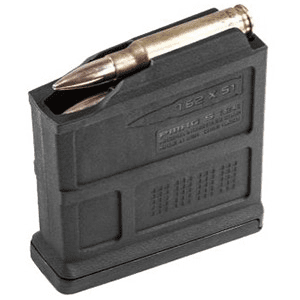 There's the abbreviated homonym for a "magazine," too. They're called "mags" quite frequently, the black one shown here is a 7.62x51mm NATO.
There's the abbreviated homonym for a "magazine," too. They're called "mags" quite frequently, the black one shown here is a 7.62x51mm NATO.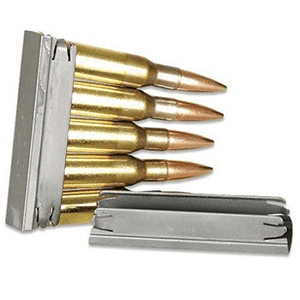 (Tip: NEVER call them "clips!" A stripper clip is a device used to speed-load certain magazines, but the word is so misused by Hollywood and the media that it really gets under gun peoples' skins and will immediately brand you as a super-duper-noob. The silver doodad seen here is a clip, NOT a magazine.)
(Tip: NEVER call them "clips!" A stripper clip is a device used to speed-load certain magazines, but the word is so misused by Hollywood and the media that it really gets under gun peoples' skins and will immediately brand you as a super-duper-noob. The silver doodad seen here is a clip, NOT a magazine.)
- Commonly Understood Shorthand: The following is a list of commonly heard shorthand nicknames for cartridges and calibers that you'll hear a lot but aren't mentioned in the previous examples. There are a great many more than these, so just consider these the highlights:
- "Two forty-three" - .243 Winchester
- "Thirty thirty" - .30-30 Winchester
- "Forty" or "Forty Smith" - .40 S&W
- "Forty-four Mag" or "Forty-four" - .44 Magnum
- "Forty-five" - usually .45 ACP, also "Forty-five Auto"
- "Six Five Creedmoor" - 6.5mm Creedmoor
- "Seven-em-em Oh Eight" - 7mm-08 Remington
- "Seven-six-two by Thirty-nine" - 7.62x39mm, also "Seven-six two by Three-nine"
- "Two-seventy" - .270 Winchester
- "Four fifty-four" - .454 Casull
- "Three-eighty" - .380 ACP
- "Fifty cal" - .50 BMG (Browning Machine Gun)
Clear As Mud?
The world of caliber naming conventions is a strange and wonderful thing that can make your head spin. Don't be worried if some or all of it confuses you; the more you get involved in shooting sports, the more you'll pick up on the lingo. For reference, we've put together a Gun Glossary that you can use to quickly look up specific information and an Ammo and Reloading Glossary. Check out our article on Selecting Ammo by Application, too; it'll help you figure out what you need depending on what you want to do. Now that you're a little savvier on common calibers and it's easy to Buy Ammo Online, shop our frequently updated inventory of In-Stock Ammo that's ready to ship today!
